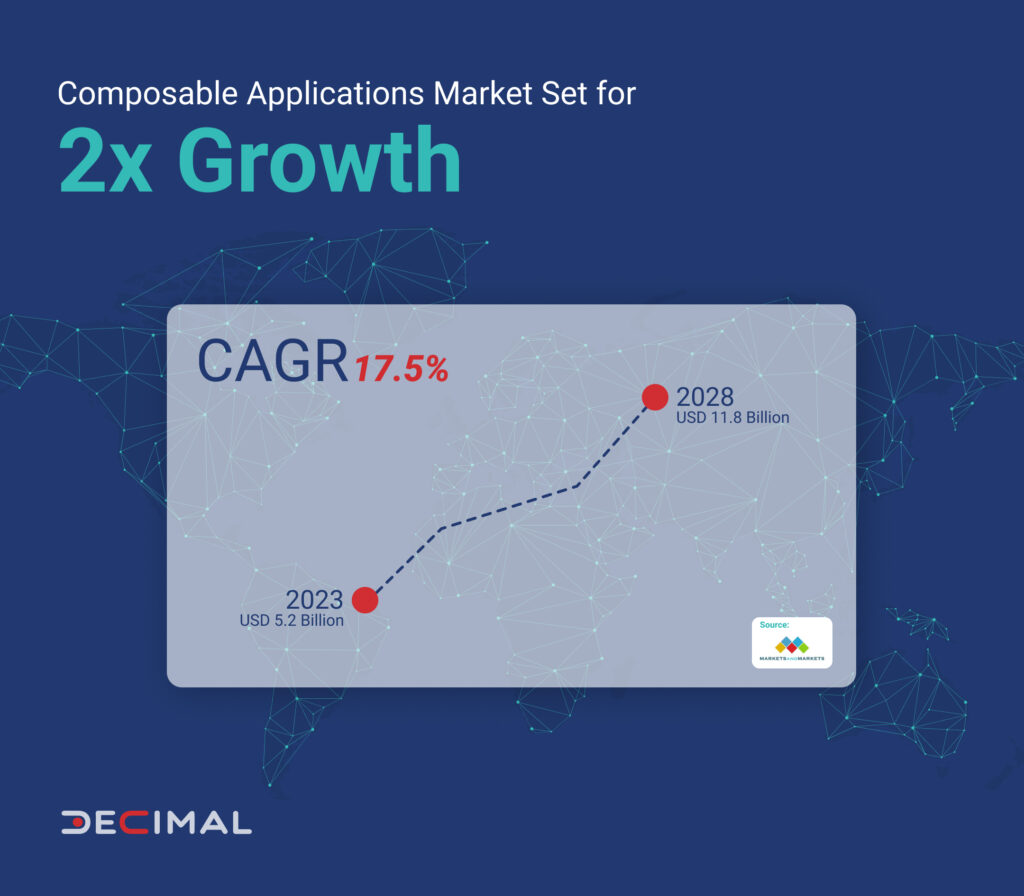According to Gartner, 30% of new applications will be composable and built using Packaged Business Capabilities (PBCs) by 2023.
Table of Contents
ToggleBut what are composable applications, and how are they different from current application development?
Why are low code development platforms being called the ultimate enabler for composable application development? Let’s talk about all this in the blog below.
What Is a Composable Application?
Composable applications are a set of independent, reusable programs that come together to create new applications whose functionality none of them could achieve independently.
In other words, it is nothing but a bunch of off-the-shelf products strung together with APIs (Application programming interfaces) to create a new application. These APIs help the programs talk to each other.
As more organizations look towards digital transformation to improve their business outcomes, it is important to keep up with the pace of application development required.
How Do Composable Applications Work?
You might think that the idea we outlined above is nothing new – APIs, after all, have existed for a long time, and reusability of code is not a new idea either. So why are we adding a new label of “composability” on top?
How is composable software different?
Previously, much more focus was on creating business logic. Well-defined, single-purpose units integrated through layers of APIs were the norm.
However, with the new era of multi-channel user engagement, infrastructure as code, and other developments, IT teams have had to think long and hard about how application building is taking place.
Today, composability runs throughout the entire application stack, and this happens through the magic of Packaged Business Capabilities (PBCs).
A PBC is a complete application in itself, with its own user interface, business logic, data layer, and everything interconnected through an API.
Let’s say you are building a business application that automates the ordering process in a business. This might include many parts – inventory, order, and customer management.
Each of these components could be a single PBC. The individual applications will not only be part of the ordering application but standalone applications on their own.
You could reuse the same customer management PBC for other applications you are building by simply using well-composed APIs to connect it with similar pieces.
What Are The Benefits of Composability?
There are many advantages to taking a reusable and packaged approach to application development.
1) It improves the scalability and adaptability of business applications. This approach builds applications quicker, faster, cheaper, and better.
2) There is no disruption of the business, unlike with traditional software, which requires stopping business (for some time) to replace an entire existing application.
3) PBCs bring about consistency in look and feel, which helps improve the multi-channel experience.
4) Repurposing existing programs and code helps to reduce the burden of new development, and of course reduces hiring costs.
5) There are fewer errors in the code because these PBCs are standalone components, which are extensively tested for the purpose they are built.
6) Less skilled programmers can also work with PBCs because they don’t need to understand the whole application to use it.
7) Composability also reduces the cost of maintaining a large IT team because existing code only needs to be reconfigured, not rewritten.
Also Read: Composable Enterprises: Unlocking Business Agility Through Business and Technical Modularity

How Low Code Enables Composability
Low Code application platforms fit perfectly into the world of composable business applications. Low-code applications are designed using pre-built, interoperable components that you can connect through a strong network of APIs.
Moreover, enterprise low code applications help build applications through easy-to-use, drag-and-drop functionality with ready-made PBCs, which is another thing that works exactly as per the principles of composability.
Integrating existing application programs is much easier with low-code platforms because they have already built a strong library of APIs for exactly this purpose.
Low code is the perfect workbench for enterprises that want to become composable. It can help build powerful, easy-to-integrate applications without disrupting business.
Final Thoughts
Composable applications are expected to grow to $95.98 bn by 2030, from a mere $2.62 bn in 2021. Growth will come across segments, be it healthcare, banking, manufacturing, or IT.
If you want to bring your business onto the composable application development model, Low code application platforms are the perfect tool for you.
FAQs (Frequently Asked Questions)
What are composable applications?
Composable applications combine independent, reusable programs (Packaged Business Capabilities or PBCs) using APIs to create new applications with functionalities that individual components cannot achieve alone.
Why should businesses adopt composable applications?
Businesses benefit from improved scalability, adaptability, and faster development cycles. Composable applications also reduce costs, minimize business disruption, and enhance consistency across multi-channel experiences.
How do Packaged Business Capabilities (PBCs) function in composable applications?
PBCs act as standalone applications with their own user interface, business logic, and data layer. Developers connect them via APIs, enabling reuse across multiple applications for faster and more efficient development.
What role do low-code platforms play in composable application development?
Low-code platforms simplify composable application development by offering pre-built, interoperable components and drag-and-drop functionality. Their robust API libraries make integrating PBCs seamless and efficient.
Which industries benefit most from composable applications?
Industries like healthcare, banking, manufacturing, and IT gain significant advantages from composable applications due to their need for scalable, adaptable, and cost-effective solutions.
People Also Ask
How do composable applications differ from traditional software?
Composable applications rely on reusable PBCs and APIs, enabling faster development, easier integration, and less disruption to business operations compared to traditional software.
What advantages do low-code platforms offer for composable applications?
Low-code platforms accelerate development, lower costs, and streamline integration by providing pre-built components and APIs, making them ideal for building composable applications.
Can businesses customize composable applications for specific needs?
Absolutely. Businesses can mix and match PBCs to create tailored solutions that address their unique requirements, ensuring flexibility and scalability.
What does the future hold for composable applications in enterprise software?
The composable application market is projected to grow to $95.98 billion by 2030, driven by the demand for scalable, adaptable, and cost-effective solutions across various industries.
How do APIs facilitate composable application development?
APIs connect PBCs, allowing them to communicate and work together seamlessly. This integration enables the creation of new applications with enhanced functionalities.
